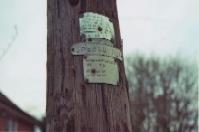Peter Borrows takes us on another excursion into local chemistry

To make the most of the chemical environment you have to be alert to the unexpected. On a country walk in the Chiltern hills, I was climbing over a stile when I glanced at the wooden pole carrying electricity cables to a nearby farm. There was a small notice attached: BORON RODS IMPLANTED. Boron? Boron rods? Whenever I have seen boron it has been as an amorphous brownish coloured powder. So what is going on? And where is the boron?
Boron battles bugs
Boron rods are used to protect wood from fungal decay and insect attack. The rods are not elemental boron but a compound, anhydrous disodium octaborate, Na2 B8 O13. The rods are inserted into pre-drilled holes in the wood and the holes capped, eg with a filler. The disodium octaborate then reacts with water soaking through the wood to liberate the active ingredient, boric acid (H3BO3).
Na2B8O13(s) + 13H2O(l) → 2NaOH(aq) + 8H3BO3(aq)
The instructions warn users to leave a small gap between the end of the rod and the end cap to allow for expansion when the reaction takes place. In damp conditions water reacts with the disodium octaborate and the boric acid then diffuses throughout the timber. Presumably the sodium hydroxide also diffuses through the wood but it is the boric acid which is lethal to insects such as ants and cockroaches.
A saturated solution of boric acid at ambient temperatures is ca 1 mol dm-3. The rods come in various sizes providing an application rate of 6.0 kg boric acid per cubic metre, which corresponds roughly to a 0.1 mol dm-3 solution.
The notice about boron rods was embossed on a rectangle of aluminium. Only a chemist would be delighted by the coincidence that boron and aluminium are in the same Group of the Periodic Table. But what a contrast between the elements - aluminium is metallic by any criteria, boron definitely not. We don't talk about aluminic acid, though aluminium is amphoteric.
Aluminium - under oxide protection
The aluminium strip was showing some signs of corrosion. There were white deposits of aluminium oxide on the surface.
4Al(s) + 3O2(g) → 2Al2O3(s)
Aluminium is used in such situations because it is resistant to corrosion. Usually the metal is protected by a very thin 'passive' oxide film, and sometimes we deliberately anodise aluminium to produce such a protective film. But, in my experience, the layer does eventually break down, especially when it is in the open air, exposed to rain etc. A good demonstration uses mercury(ii) chloride to destroy the passive layer, and the underlying aluminium then reacts vigorously with water or air. However, I've not found a convincing explanation for why the passive film breaks down when exposed to rain. Is it the pollution? Perhaps it is worth getting across to your classes that science doesn't have all the answers and there is still some research left for scientists to do.
While corrosion of the aluminium may not be obvious, the iron nails holding the notice in place are obviously corroded - look at the brown stains. Although aluminium, as the more reactive metal, should corrode in preference to the iron, in practice the passive oxide film on the aluminium protects it for some time.
So, in one short observation plus a bit of research, some boron chemistry, some aluminium chemistry and some iron chemistry - not to mention solubility, diffusion, hydrolysis, oxidation and the reactivity series. Not bad for a country walk.






No comments yet